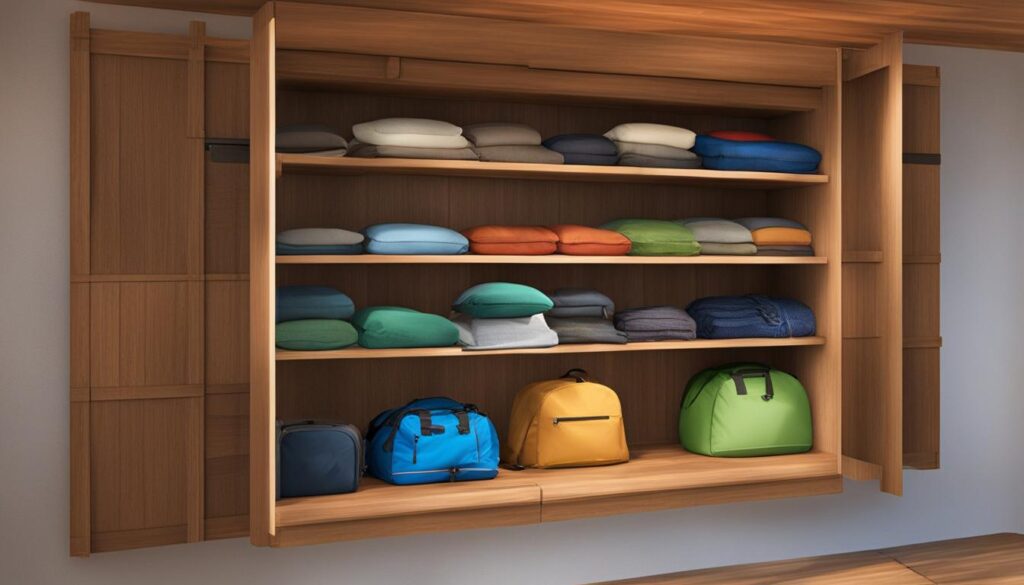Storing camping gear properly is crucial to ensure its longevity and convenience for future adventures. Leaving gear packed up and unorganized can lead to damage, rust, and create an ideal environment for pests. To optimize space and keep camping equipment organized, it is important to inspect gear for damage, clean it thoroughly before storage, and create a dedicated storage space. This can include utilizing areas such as the garage, basement, closets, or storage sheds. Organizing small gear and accessories with labeled bins and using hanging shoe racks and overhead space can further optimize storage. Properly storing gear like tents, packs, sleeping gear, and cooking equipment is essential to prolong their life and prevent damage.
Table of Contents
Key Takeaways:
- An organized storage system for camping gear is essential to ensure its longevity and convenience.
- Inspect and clean gear before storage to prevent damage and rust.
- Create a dedicated storage space, utilizing areas like closets, garages, or storage sheds.
- Utilize labeled bins, hanging shoe racks, and overhead space for optimizing storage.
- Properly store tents, packs, sleeping gear, and cooking equipment to prolong their life.
With these storage solutions in place, you can optimize the storage of your camping equipment, keeping it well-maintained, easily accessible, and ready for your next outdoor adventure.
Indoor and Outdoor Storage Solutions for Camping Gear
When it comes to storing your camping gear, having the right storage solutions can make all the difference. Whether you need a compact bookshelf for outdoor equipment or portable storage for camping gear, there are various options available to meet your needs.
Indoor Storage Solutions
For indoor storage, consider utilizing wall-mounted racks and hooks to hang larger items such as tents and backpacks. Pegboard storage is another versatile option that allows you to customize your storage space by adding shelves, hooks, and baskets. Clear storage containers can help you easily identify and access smaller items like cooking utensils and accessories.
Utilizing vertical space is key to optimizing storage in small areas. Consider installing hanging walls or utilizing corner shower shelves to make the most of your space. Hanging shoe racks can be repurposed to store smaller camping essentials such as flashlights, batteries, and toiletries.
Outdoor Storage Solutions
When it comes to outdoor storage, weatherproof cabinets and sheds are excellent options for keeping your camping gear safe from the elements. Look for lockable metal cabinets to ensure the security of your valuable equipment. If you have limited outdoor space, compact storage sheds can provide a convenient solution.
In the garage, consider installing ceiling-mounted shelving to maximize storage space. Customizable storage rails are another great option for keeping your camping gear organized and easily accessible.
Labeling and Inventory Management
No matter which storage solutions you choose, it’s important to label and inventory your items. This will help you keep track of your gear and ensure that you have everything you need for your next camping trip. Consider using checklists to make sure you don’t forget any essential items.
By utilizing indoor and outdoor storage solutions, organizing your camping gear becomes a breeze. With a well-organized storage system in place, you’ll be able to find and pack your gear quickly, leaving you more time to enjoy the great outdoors.
| Storage Solution | Indoor | Outdoor |
|---|---|---|
| Wall-mounted Racks and Hooks | ✔️ | |
| Pegboard Storage | ✔️ | |
| Clear Storage Containers | ✔️ | |
| Hanging Walls | ✔️ | |
| Corner Shower Shelves | ✔️ | |
| Hanging Shoe Racks | ✔️ | |
| Weatherproof Cabinets | ✔️ | |
| Lockable Metal Cabinets | ✔️ | |
| Compact Storage Sheds | ✔️ | |
| Ceiling-Mounted Shelving | ✔️ | |
| Customizable Storage Rails | ✔️ |
Conclusion
When it comes to camping, optimizing storage for your equipment is key to a successful and stress-free experience. By implementing a few simple strategies, you can ensure that your camping gear remains organized, easily accessible, and in top condition for future adventures.
First and foremost, it is essential to thoroughly inspect and clean your gear before storing it. This helps prevent any damage or deterioration that may occur over time. Take the time to examine each item and make any necessary repairs or replacements.
Next, create a dedicated storage space for your camping equipment. This could be a corner of your garage, a closet, or even a storage shed. Having a designated area not only keeps things organized but also makes it easier to find what you need when it’s time to pack for your next trip.
Utilizing various storage solutions can also help optimize the space available to you. Shelves, hooks, bins, and racks are all great options for keeping your gear neatly organized. Labeling your storage containers and utilizing an inventory system can further streamline the process, ensuring that you always have an accurate record of what you have.
By taking these steps to optimize your camping gear storage, you’ll save time and energy when it comes to packing for your trips. You’ll also extend the lifespan of your gear, meaning you won’t have to constantly replace items due to damage or disorganization. So, start optimizing your storage today and enjoy hassle-free camping adventures in the future!
FAQ
Why is it important to store camping gear properly?
Storing camping gear properly is crucial to ensure its longevity and convenience for future adventures. Leaving gear packed up and unorganized can lead to damage, rust, and create an ideal environment for pests.
What should I do before storing my camping gear?
Before storing your camping gear, it is important to inspect the gear for damage and clean it thoroughly. This will prevent any existing damage from worsening and ensure that the gear is ready to use for future trips.
Where should I store my camping equipment?
Creating a dedicated storage space for your camping equipment is essential. This can include utilizing areas such as the garage, basement, closets, or storage sheds. The key is to choose a space that is dry, cool, and protected from extreme temperatures.
What are some storage solutions for camping gear?
Indoor storage solutions for camping gear include wall-mounted racks and hooks, pegboard storage, shelves, and clear storage containers. Outdoor storage options include weatherproof cabinets and sheds, lockable metal cabinets, and compact storage sheds. Utilizing vertical space and utilizing corner shower shelves can also maximize storage in small spaces.
How can I optimize storage for camping equipment in a small space?
In small spaces, it is important to utilize every inch of available space. This can be done by using hanging shoe racks, overhead space, and collapsible storage containers. Additionally, maximizing vertical space with wall-mounted racks and utilizing corner shower shelves can further optimize storage.
How should I label and inventory my camping gear?
Labeling and inventorying your camping gear is important to keep track of items and ensure nothing gets lost. Use labels on bins and storage containers, and consider creating an inventory list or using an inventory management app to keep track of your gear.
What is the benefit of using checklists for camping trips?
Checklists are a great way to ensure that you pack all the necessary items for each camping trip. By creating a checklist, you can avoid forgetting essential gear and make sure you are fully prepared for your outdoor adventures.


